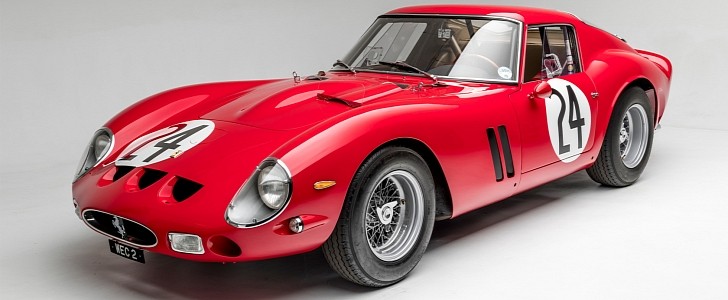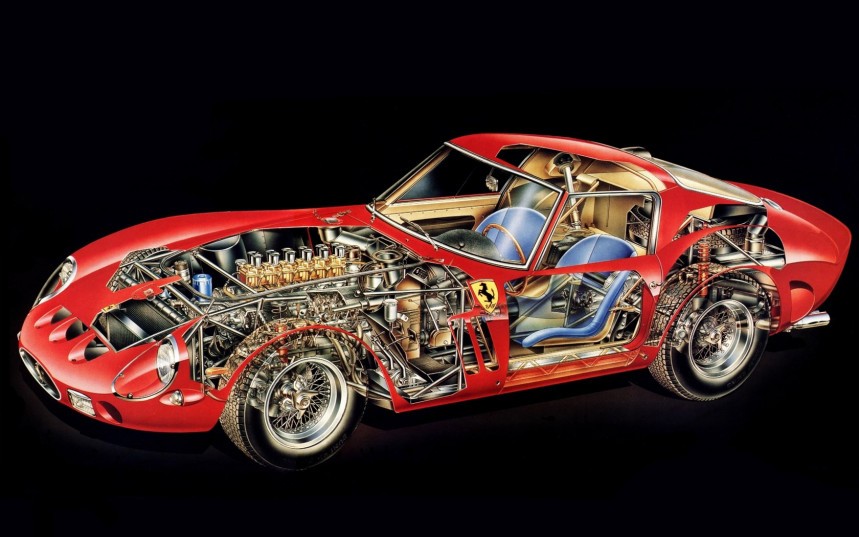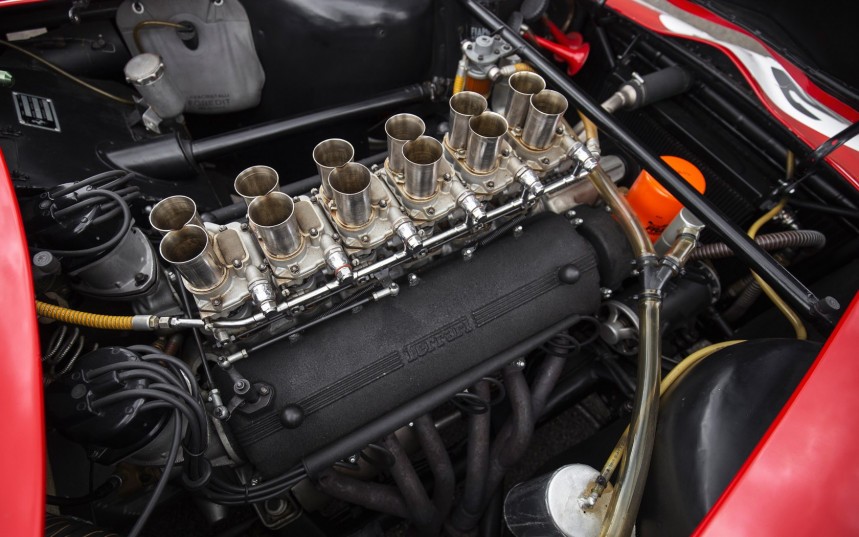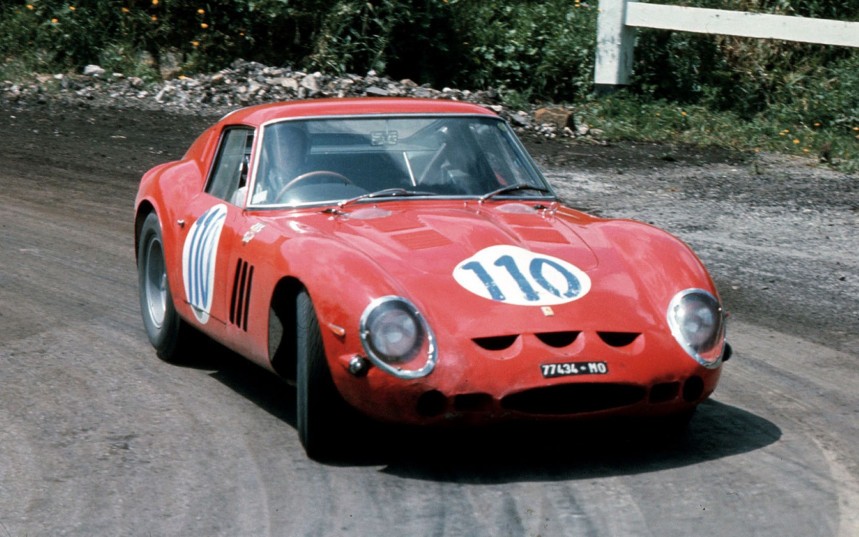The 250 GTO is one of the greatest sports cars ever built, arguably the best Ferrari to come out of the Maranello factory, and it has become the most expensive car in the world. It is a legend of the automotive industry with an illustrious history steeped in performance and innovation.
In the late fifties Giotto Bizzarrini, Ferrari's experimental sports car development chief at that time, was tasked to create a new sports car that would be capable of beating the Jaguar E-Type in the Group 3 racing class of the World Sportscar Championship.
He based the new prototype on a 250 GT ‘passo corto’ with chassis number 1791GT, but before he could complete the project, he was fired along with most of the company’s engineers in 1962, after an argument with the big boss.
Development of the 250 GTO was halted at a critical point, with the chassis and styling left unfinished. The enormous pressure of completing the project was handed down to long-time designer Sergio Scaglietti and a young engineer named Mauro Forghieri.
The chassis, which was heavily based on the 250 GT, was built on a 2,400-mm (94.5 in) wheelbase using smaller section hand-welded steel tubing. Additional braces were added to increase torsional rigidity while the geometry and structure were modified to lower the center of gravity.
The team of engineers designed a fully independent suspension system, which used an A-arm layout in the front while the rear featured twin radius arms, semi-elliptic springs, and a solid axle with Watt's linkage.
Power came from the proven Tipo 168/62 Colombo 3.0-liter V12 engine used in the legendary 250 Testa Rossa Le Mans winner. The all-alloy unit was designed with a 60-degree V configuration. It used two valves per cylinder, six 38DCN Weber carburetors, and a dry-sump lubrication system.
It produced roughly 300 PS (296 bhp; 221 kW) at 7,500 rpm, and 294 Nm (217 lb-ft) of torque at 5,500 rpm, which is in the same category as a modern-day Nissan Maxima V6. For those times, though, it was a marvel of engineering and one of the most capable engines out there.
Matted to it was a new 5-speed gearbox with Porsche-type synchromesh, with stopping power provided by a high-performance disc brake system.
Bizzarrini focused on improving the car’s aerodynamics and thus making it faster, testing an early prototype and several building methods in a wind tunnel at the Pisa University. Scaglietti completed his work and added a rear spoiler after early testing. The result was an all-aluminum body that has become legendary and is considered by many as the most beautiful ever created.
On the inside, to avoid added weight, the 250 GTO had to do with small, cloth-upholstered seats, no carpeting or headliner; early models didn’t even use a speedometer.
The car made its racing debut at the 1962 12 Hours of Sebring, driven by Phil Hill, who at the time was the reigning Formula One world champion, and Belgian driver Olivier Gendebien. The two managed to finish second, behind a Ferrari 250 Testa Rossa driven by Jo Bonnier and Ludovico Scarfiotti.
That year Ferrari would win the ‘over 2,000cc’ class of the FIA International Championship for GT Manufacturers racing the 250 GTO, a performance that was repeated in 1963 and 1964. During the same period, the car was also triumphant at the Tour de France Automobile, extending Ferrari's dominance at the fabled race.
Only 36 units were produced from 1962 to 1964, divided into two series. The first 33 were built from 1962 to 1963, while the other 3 rolled out the factory gates in 1964, featuring a similar bodywork to the Ferrari 250 LM. Four cars from the first series were also updated in the same year with the new bodywork.
When new, the 250 GTO sold for around $18,000 to buyers being personally approved by Enzo Ferrari or, in the U.S., by his trusted partner, former driver Luigi Chinetti.
It has become the most sought-after classic car of all time since then, and it set a record for the world's most expensive car in 2018 when the 1963 chassis model 4153GT sold for $70 million.
He based the new prototype on a 250 GT ‘passo corto’ with chassis number 1791GT, but before he could complete the project, he was fired along with most of the company’s engineers in 1962, after an argument with the big boss.
Development of the 250 GTO was halted at a critical point, with the chassis and styling left unfinished. The enormous pressure of completing the project was handed down to long-time designer Sergio Scaglietti and a young engineer named Mauro Forghieri.
The chassis, which was heavily based on the 250 GT, was built on a 2,400-mm (94.5 in) wheelbase using smaller section hand-welded steel tubing. Additional braces were added to increase torsional rigidity while the geometry and structure were modified to lower the center of gravity.
Power came from the proven Tipo 168/62 Colombo 3.0-liter V12 engine used in the legendary 250 Testa Rossa Le Mans winner. The all-alloy unit was designed with a 60-degree V configuration. It used two valves per cylinder, six 38DCN Weber carburetors, and a dry-sump lubrication system.
It produced roughly 300 PS (296 bhp; 221 kW) at 7,500 rpm, and 294 Nm (217 lb-ft) of torque at 5,500 rpm, which is in the same category as a modern-day Nissan Maxima V6. For those times, though, it was a marvel of engineering and one of the most capable engines out there.
Bizzarrini focused on improving the car’s aerodynamics and thus making it faster, testing an early prototype and several building methods in a wind tunnel at the Pisa University. Scaglietti completed his work and added a rear spoiler after early testing. The result was an all-aluminum body that has become legendary and is considered by many as the most beautiful ever created.
On the inside, to avoid added weight, the 250 GTO had to do with small, cloth-upholstered seats, no carpeting or headliner; early models didn’t even use a speedometer.
The car made its racing debut at the 1962 12 Hours of Sebring, driven by Phil Hill, who at the time was the reigning Formula One world champion, and Belgian driver Olivier Gendebien. The two managed to finish second, behind a Ferrari 250 Testa Rossa driven by Jo Bonnier and Ludovico Scarfiotti.
Only 36 units were produced from 1962 to 1964, divided into two series. The first 33 were built from 1962 to 1963, while the other 3 rolled out the factory gates in 1964, featuring a similar bodywork to the Ferrari 250 LM. Four cars from the first series were also updated in the same year with the new bodywork.
When new, the 250 GTO sold for around $18,000 to buyers being personally approved by Enzo Ferrari or, in the U.S., by his trusted partner, former driver Luigi Chinetti.
It has become the most sought-after classic car of all time since then, and it set a record for the world's most expensive car in 2018 when the 1963 chassis model 4153GT sold for $70 million.












